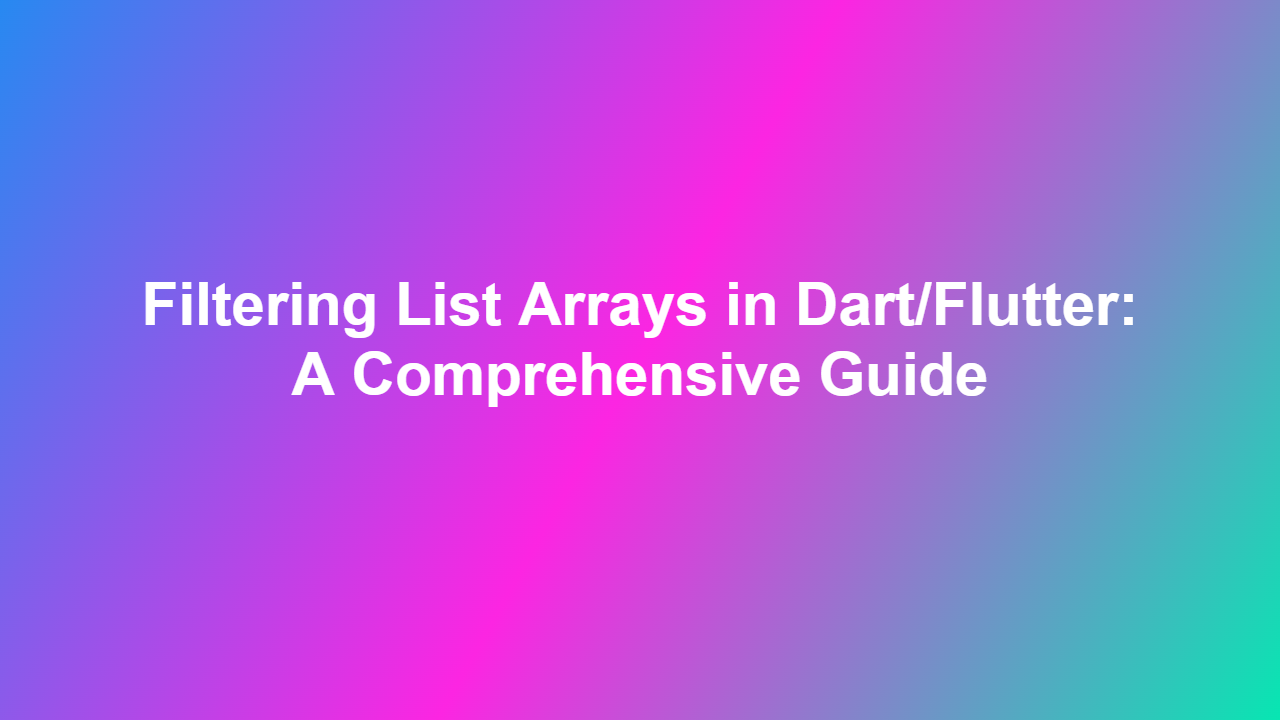Filtering List Arrays in Dart/Flutter: A Comprehensive Guide
Introduction
In Dart/Flutter development, working with lists is an essential part of building robust and efficient applications. However, as your application grows, managing large lists of data can become overwhelming. That’s where filtering comes into play – a crucial skill to master for any Flutter developer. In this article, we’ll explore how to filter list arrays in Dart/Flutter, including the different methods and best practices to achieve this.
Why Filtering is Important
Filtering is an essential data manipulation technique that helps you extract relevant data from a list based on specific criteria. This is particularly useful when you need to display a subset of data in your application’s UI. By filtering your data, you can:
- Reduce computational overhead
- Improve user experience by displaying relevant data
- Simplify data analysis and debugging
Method 1: Using the `where` Method
One of the most common ways to filter a list in Dart/Flutter is by using the `where` method. This method takes a closure (an anonymous function) as an argument, which is used to evaluate each element in the list.
“`dart
// Sample list
List
// Filter numbers greater than 5
List
print(filteredNumbers); // Output: [6, 7, 8, 9, 10]
“`
Method 2: Using `filter` and Closures
Another way to filter a list is by using the `filter` method, which is similar to `where`. However, `filter` returns an iterable, so you need to convert it to a list using the `toList` method.
“`dart
// Sample list
List
// Filter numbers greater than 5
Iterable
// Convert filtered iterable to list
List
print(filteredNumbersList); // Output: [6, 7, 8, 9, 10]
“`
Method 3: Using a Custom Comparator
In some cases, you may need to filter a list based on multiple criteria or complex conditions. In such cases, a custom comparator can be useful. A comparator is a function that takes two elements and returns a boolean value indicating whether the first element should be considered before the second.
“`dart
// Sample list
List
// Custom comparator to sort names alphabetically
List
// Filter names starting with ‘A’
List
print(filteredNames); // Output: [‘Alice’]
“`
Method 4: Using a `Map` Function
If you need to filter a list based on a specific property of the elements, using the `map` method can be an efficient solution. This method applies a given function to each element in the list, returning a new list with the results.
“`dart
// Sample list
List
Product(name: ‘Product A’, price: 10),
Product(name: ‘Product B’, price: 20),
Product(name: ‘Product C’, price: 30),
];
// Filter products with price above 20
List
print(filteredProducts); // Output: [30]
“`
Tips and Best Practices
When filtering large lists, remember to:
- Avoid using `where` or `filter` when the filter condition is complex, as it can lead to slower performance.
- Use a custom comparator or a `Map` function when filtering by multiple criteria or complex conditions.
- Consider using a library like `collection` or `package:collection` for more efficient filtering operations.
- Always test and profile your filtering code to ensure optimal performance.
FAQs
1. How do I filter a list in Dart/Flutter?
You can use the `where` method, `filter` method, or a custom comparator to filter a list in Dart/Flutter.
2. What is the difference between `where` and `filter` methods?
The `where` method returns a new list, while the `filter` method returns an iterable. In both cases, you need to convert the result to a list using `toList`.
3. How do I filter a list based on multiple criteria?
You can use a custom comparator or a `Map` function to filter a list based on multiple criteria.
4. Why is filtering a list important in Dart/Flutter development?
Filtering helps you extract relevant data from a list based on specific criteria, which improves user experience, reduces computational overhead, and simplifies data analysis and debugging.
5. What are some best practices for filtering lists in Dart/Flutter?
Avoid using `where` or `filter` for complex filter conditions. Use custom comparators or `Map` functions for filtering by multiple criteria. Test and profile your filtering code for optimal performance.
